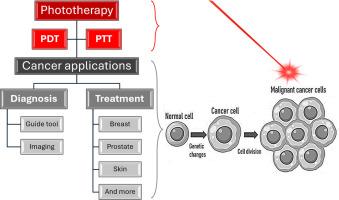Clinical and pre-clinical advances in the PDT/PTT strategy for diagnosis and treatment of cancer
IF 3.1
3区 医学
Q2 ONCOLOGY
引用次数: 0
Abstract
Photodynamic therapy (PDT) and photothermal therapy (PTT) have demonstrated great potential to diagnose and combat localized cancers. As a matter of fact, these techniques are less invasive and have fewer side effects than traditional cancer treatments like surgery, chemotherapy or radiotherapy. This review summarizes the clinical progress in the theranostics (diagnosis and treatment) of various types of regional cancers using these two light stimuli techniques, PDT and PTT. Therefore, clinical advances in cancer diagnosis based on PDT are detailed, including fluorescence-guided PDT for intraoperative cancer detection, optical coherence tomography (OCT)-guided PDT for early cancer detection, and imaging by magnetic resonance imaging (MRI) or computed tomography (CT) assisted through PDT/PTT. Moreover, clinical studies of breast, prostate, skin, gynecologic, head, neck and other varieties of cancer have been addressed to compare the main conditions of these treatments. This work also discussed the principal advantages and drawbacks of PDT and PTT in tumor targeting and cancer therapy. Finally, the usage of nanoparticles as photosensitizers (PSs) and photothermal agents (PAs) have been analyzed. In this manner, the authors have compiled relevant updated studies so that researchers interested in these areas can access it speedily.

用于诊断和治疗癌症的 PDT/PTT 策略的临床和临床前进展。
光动力疗法(PDT)和光热疗法(PTT)在诊断和治疗局部癌症方面已显示出巨大的潜力。事实上,与手术、化疗或放疗等传统癌症治疗方法相比,这些技术的创伤更小、副作用更少。本综述总结了利用这两种光刺激技术(PDT 和 PTT)对各种局部癌症进行治疗(诊断和治疗)的临床进展。因此,详细介绍了基于光动力疗法的癌症诊断的临床进展,包括用于术中癌症检测的荧光引导光动力疗法、用于早期癌症检测的光学相干断层扫描(OCT)引导光动力疗法,以及通过光动力疗法/光动力疗法辅助磁共振成像(MRI)或计算机断层扫描(CT)成像。此外,还对乳腺癌、前列腺癌、皮肤癌、妇科癌、头颈部癌和其他癌症进行了临床研究,以比较这些疗法的主要情况。这项工作还讨论了 PDT 和 PTT 在肿瘤靶向和癌症治疗中的主要优点和缺点。最后,还分析了纳米粒子作为光敏剂(PSs)和光热剂(PAs)的用途。通过这种方式,作者汇编了相关的最新研究,以便对这些领域感兴趣的研究人员能够快速查阅。
本文章由计算机程序翻译,如有差异,请以英文原文为准。
求助全文
约1分钟内获得全文
求助全文
来源期刊

Photodiagnosis and Photodynamic Therapy
ONCOLOGY-
CiteScore
5.80
自引率
24.20%
发文量
509
审稿时长
50 days
期刊介绍:
Photodiagnosis and Photodynamic Therapy is an international journal for the dissemination of scientific knowledge and clinical developments of Photodiagnosis and Photodynamic Therapy in all medical specialties. The journal publishes original articles, review articles, case presentations, "how-to-do-it" articles, Letters to the Editor, short communications and relevant images with short descriptions. All submitted material is subject to a strict peer-review process.
 求助内容:
求助内容: 应助结果提醒方式:
应助结果提醒方式:


